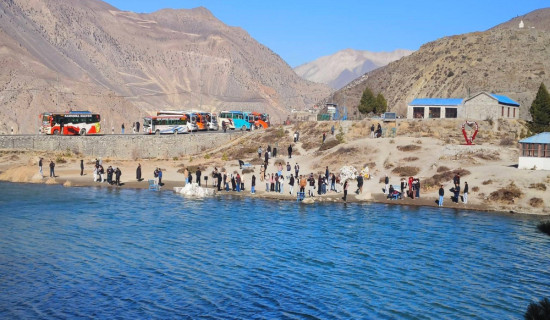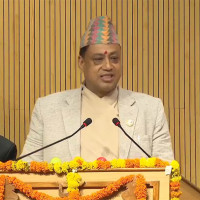- Wednesday, 21 January 2026
Terai facing drought situation in mid-monsoon
Kathmandu, Aug. 2: At a time when the monsoon season has reached its halfway point, nearly all the Terai districts, except for Morang, are facing a situation of extreme drought thanks to the below-average rainfall.
From June 1 to August 1, the country received a total of 665.7 mm of rainfall, accounting for 45.2 per cent of the monsoon's overall precipitation, which amounted to 1472 mm (from June 1 to September 30).
However, during the period from June 1 to August 1, the country received only 85.1 per cent of rainfall, which is also below the average rainfall.
However, more rainfall deficit was concentrated in the Tarai region with 20 to 40 per cent below the average, as reported by the Department of Hydrology and Meteorology (DHM).
The DHM had already predicted below-normal rainfall in most parts of the country this monsoon.
Until August 1, the Terai region received below-normal rainfall, said Sudarshan Humagain, a meteorologist at the DHM.
The rainfall measurement centres of Dhangadhi, Surkhet, Nepalgunj, Bhairahawa, Simara, Janakpur and Dhankuta recorded below-normal precipitation this year. Among these districts, Dhanusha received rainfall below 20 per cent of the average while the rainfall in Nepalgunj and Dhankuta was 40 per cent below the average precipitation.
According to Humagain, Kathmandu has, however, been fortunate to receive normal rainfall until August 1.
He said that even though the rainfall was below average, a reduction in potential monsoon-related disasters could not be guaranteed.
The intensity and impact of such disasters are influenced by various factors, including the monsoon’s behaviour and the specific conditions during the season, he said.
Therefore, despite the current rainfall situation, it is crucial to remain vigilant and prepared for any potential monsoon-related disasters that may arise, the DHM said.
Madhukar Upadhya, a senior watershed expert, attributes the unpredictable rainfall conditions to global warming. He said that the phenomena like El Niño, a climate pattern characterised by the unusual warming of surface waters in the eastern equatorial Pacific Ocean, could weaken the monsoon.
El Niño occurs when the ocean temperatures in the central and eastern Pacific Oceans rise above normal, impacting global weather patterns, including the monsoon in the Indian subcontinent.
Upadhya stated that in recent years, there has been an observable trend of high-intensity rainfall occurring within short durations. This type of rainfall can contribute to rising temperatures and more monsoon-related disasters, he added.
He also mentioned that changes in the rainfall pattern, such as shifts in the monsoon period and increased instances of drought during the winter could be attributed to the impact of climate change.
He further said that winter rainfall is vital for accumulating snow in the mountains, which serves as the main water source for downstream communities.
Experts warned that these alterations in the climate and weather patterns would have significant implications for the environment, agriculture, and water resources.







-square-thumb.jpg)








